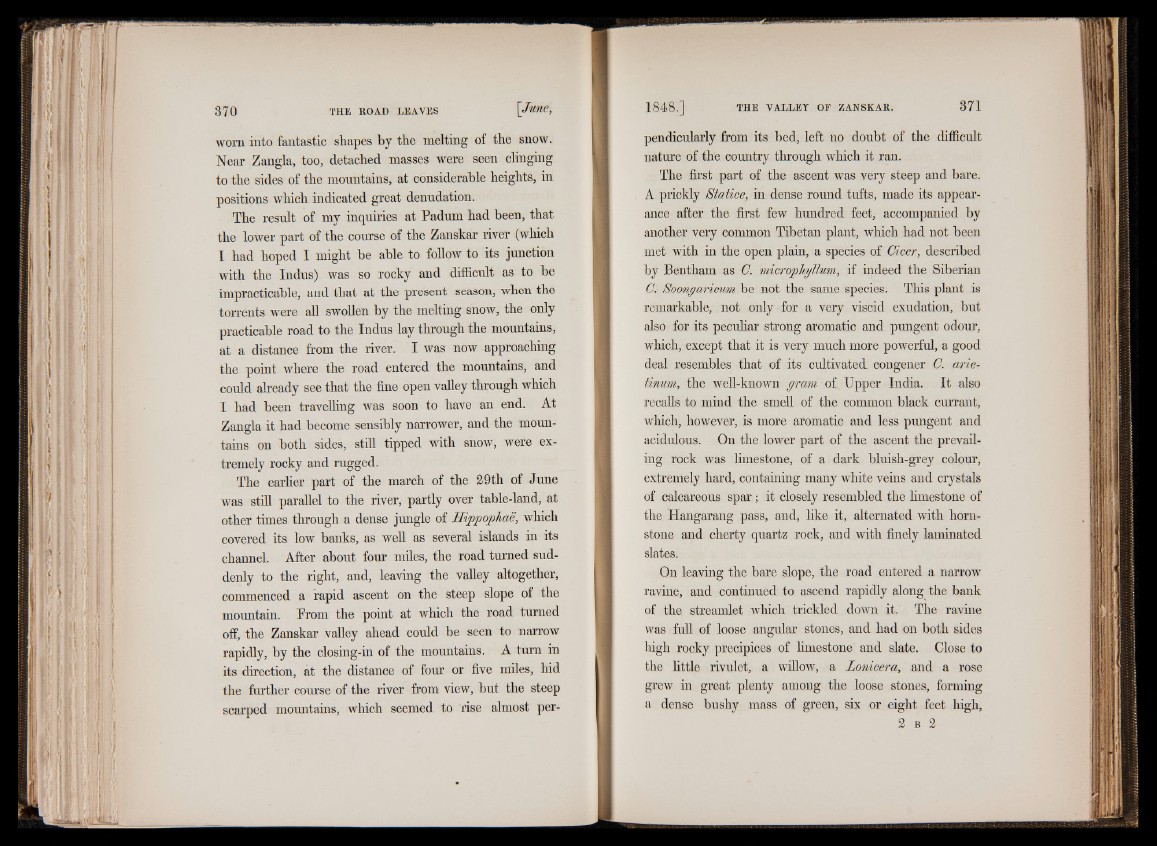
worn into fantastic shapes by the melting of the snow.
Near Zangla, too, detached masses were seen clinging
to the sides of the mountains, at considerable heights, in
positions which indicated great denudation.
The result of my inquiries at Padum had been, that
the lower part of the course of the Zanskar river (which
I had hoped I might be able to follow to its junction
with the Indus) was so rocky and difficult as to be
impracticable, and that at the present season, when the
torrents were all swollen by the melting snow, the only
practicable road to the Indus lay through the mountains,
at a distance from the river. I was now approaching
the point where the road entered the mountains, and
could already see that the fine open valley through which
I had been travelling was soon to have an end. At
Zangla it had become sensibly narrower, and the mountains
on both sides, still tipped with snow, were extremely
rocky and rugged.
The earlier part of the march of the 29th of June
was still parallel to the river, partly over table-land, at
other times through a dense jungle of Hippophari, which
covered its low banks, as well as several islands in its
channel. After about four miles, the road turned suddenly
to the right, and, leaving the valley altogether,
commenced a rapid ascent on the steep slope of the
mountain. Prom the point at which the road turned
off, the Zanskar valley ahead could be seen to narrow
rapidly, by the closing-in of the mountains. A turn in
its direction, at the distance of four or five miles, hid
the further course of the river from view, but the steep
scarped mountains, which seemed to rise almost perpendicularly
from its bed, left no doubt of the difficult
nature of the country through which it ran.
The first part of the ascent was very steep and bare.
A prickly Statice, in dense round tufts, made its appearance
after the first few hundred feet, accompanied by
another very common Tibetan plant, which had not been
met with in the open plain, a species of Cicer, described
by Bentham as C. microphyllum, if indeed the Siberian
C. Soongaricum be not the same species. This plant is
remarkable, not only for a very viscid exudation, but
also for its peculiar strong aromatic and pungent odour,
which, except that it is very much more powerful, a good
deal resembles that of its cultivated congener C. arie-
tinum, the well-known gram of Upper India. It also
recalls to mind the smell of the common black currant,
which, however, is more aromatic and less pungent and
acidulous. On the lower part of the ascent the prevailing
rock was limestone, of a dark bluish-grey colour,
extremely hard, containing many white veins and crystals
of calcareous spar; it closely resembled the limestone of
the Hangarang pass, and, like it, alternated with horn-
stone and cherty quartz rock, and with finely laminated
slates.
On leaving the bare slope, the road entered a narrow
ravine, and continued to ascend rapidly along the bank
of the streamlet which trickled down it. The ravine
was full of loose angular stones, and had on both sides
high rocky precipices of limestone and slate. Close to
the little rivulet, a willow, a Lonicera, and a rose
grew in great plenty among the loose stones, forming
a dense bushy mass of green, six or eight feet high,
2 b 2